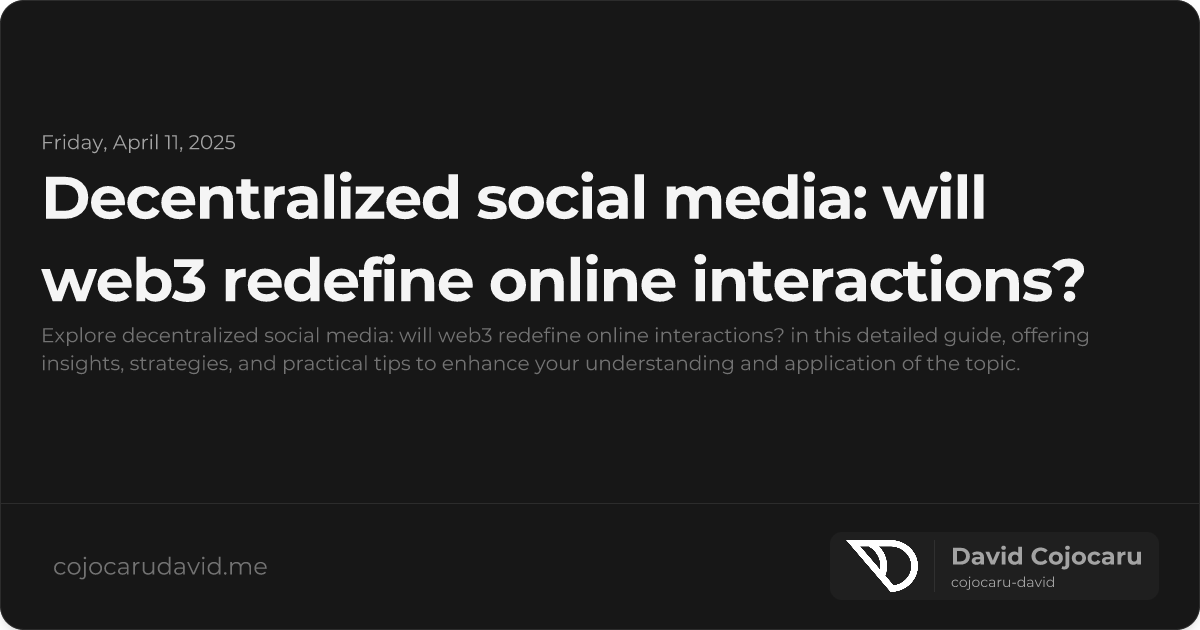Decentralized Social Media: Can Web3 Truly Reimagine Online Connection?
The rise of decentralized social media platforms is generating considerable buzz, promising a new era of online interaction powered by Web3 technologies like blockchain, smart contracts, and tokenized economies. As users increasingly voice concerns about data privacy, algorithmic manipulation, and centralized control on traditional platforms, decentralized networks offer a compelling alternative: greater transparency, ownership, and control over their digital lives. But can Web3 truly reimagine how we connect online, or is it simply a passing tech trend?
Understanding Decentralized Social Media
Decentralized social media platforms, built on blockchain networks, shift power away from centralized corporations like Meta and X (formerly Twitter). Instead of a single entity controlling the platform, users own their data, participate in governance, and potentially earn rewards for their contributions.
Key characteristics of decentralized social media include:
- User Data Ownership: Individuals, not corporations, control their data and content.
- Censorship Resistance: No single entity can unilaterally censor or remove content, fostering a more open environment.
- Monetization Opportunities: Creators can directly monetize their content through tokens, NFTs, microtransactions, and other innovative mechanisms.
How Web3 is Transforming Social Networking Dynamics
1. Empowering Users with True Data Ownership
Unlike traditional platforms that profit from user data, Web3 social networks leverage decentralized ledgers to store information. Users maintain control over their data through cryptographic keys, ensuring privacy, security, and the ability to port their data between platforms. This fosters a more user-centric approach to data management.
2. Building Community-Driven Governance Models
Platform policies, moderation practices, and future upgrades are often determined through decentralized autonomous organizations (DAOs). Token holders actively participate in shaping the platform’s trajectory by voting on proposals, fostering a sense of community ownership and democratizing the platform’s evolution.
3. Incentivizing Engagement Through Tokenomics
Web3 platforms often reward active participation with native tokens, creating a more engaging and rewarding experience for users. Examples include:
- Earning tokens for creating and sharing high-quality content.
- Incentivizing curation activities (liking, sharing, commenting) to promote valuable content.
- Staking tokens to gain governance rights and influence platform decisions.
Navigating the Challenges of Decentralized Social Media
While the potential of Web3 social media is undeniable, several challenges need to be addressed for wider adoption:
- Scalability Bottlenecks: Blockchain networks can struggle to handle the high transaction volumes and speeds required for mainstream social media use, leading to slow performance and high transaction costs.
- User Experience Complexities: The technical complexities of crypto wallets, private keys, and blockchain technology can be daunting for non-crypto native users, hindering adoption.
- Content Moderation Dilemmas: Balancing free speech principles with the need to address harmful content (hate speech, misinformation) is a significant challenge without centralized oversight, requiring innovative and community-driven solutions.
The Future Landscape of Online Interactions
If Web3 social media platforms can overcome these challenges, they have the potential to shift power from corporations back to individuals, creating a more equitable and user-centric digital landscape. However, mainstream adoption hinges on solving usability hurdles and scalability issues.
“Decentralized social media isn’t just a technological shift; it’s a movement towards reclaiming digital autonomy and fostering a more democratic online experience.”
The evolution of decentralized social media will ultimately determine whether Web3 fundamentally reimagines online connection or remains a niche alternative. Regardless, the conversation surrounding data ownership, user control, and the future of online platforms has only just begun.

